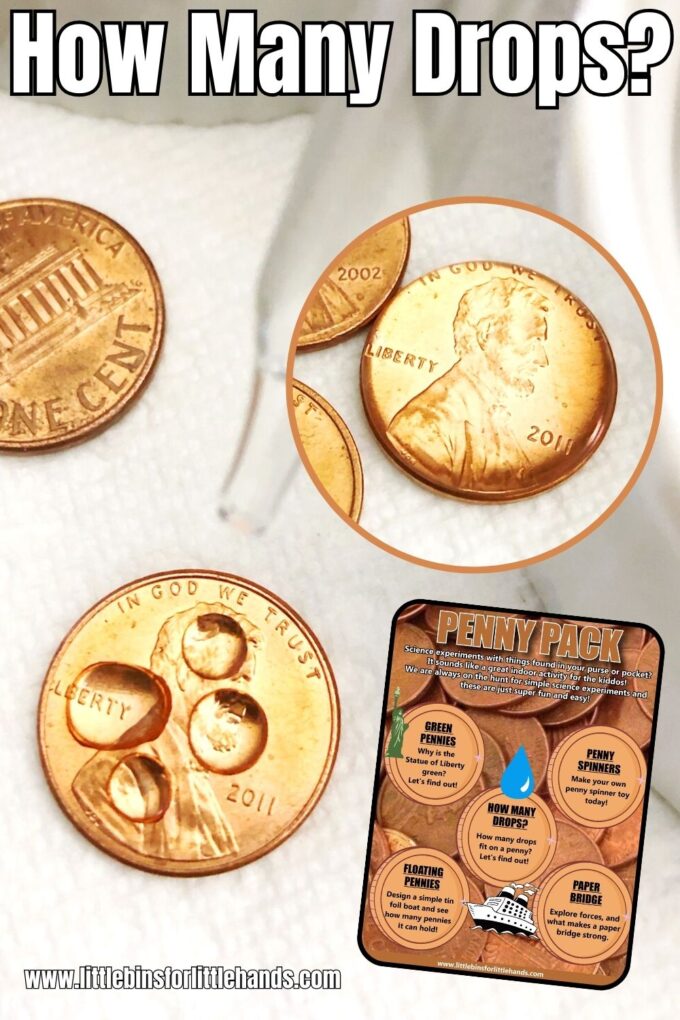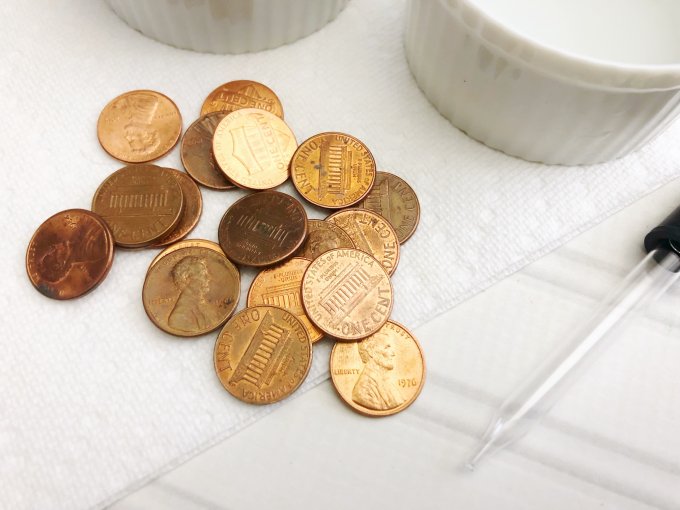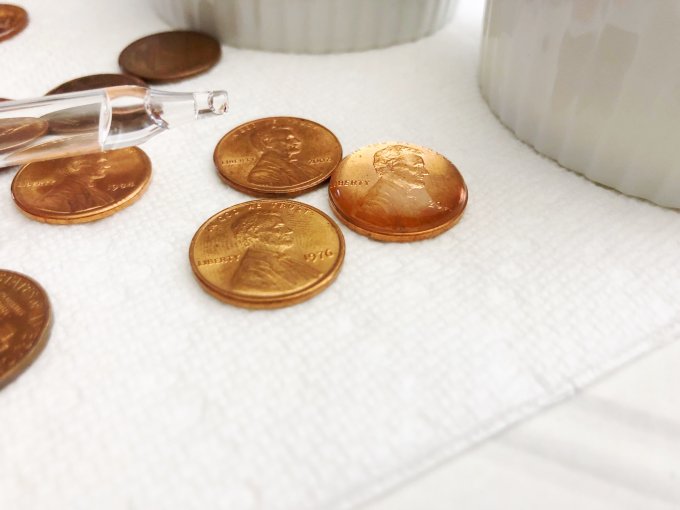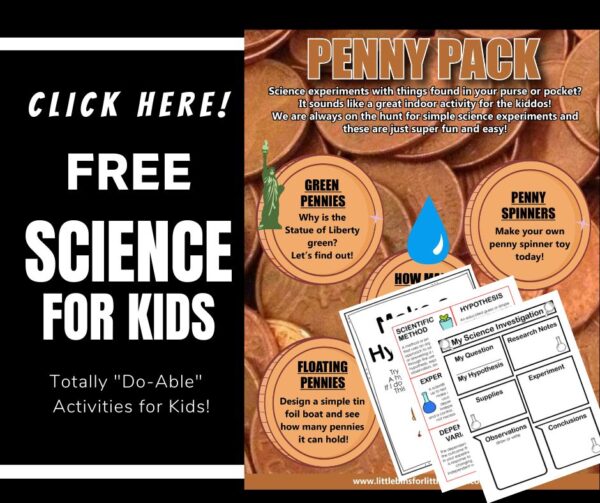Have you ever thought about how many drops of water can fit on a penny? Try this fun science experiment with things found in your purse or pocket! Explore the surface tension of water with this fun and easy penny lab with the kids. We are always on the hunt for simple science experiments, and this one is just super fun and easy!

Explore How Many Water Drops On Penny
Get ready to add this simple penny lab to your science activities this season. If you want to learn about the surface tension of water, let’s dig in. While you’re at it, make sure to check out these other fun water science experiments.
Our science activities and experiments are designed with you, the parent or teacher, in mind! Easy to set up and quick to do, most activities take only 15 to 30 minutes to complete and are loads of fun! Plus, our supplies lists usually contain only free or cheap materials you can source from home!
Use the Scientific Method
This drops of water on a penny experiment is a fantastic opportunity to use the scientific method and record your experiment using the free mini worksheet pack below.
You can read about using the scientific method here, and find more information on the independent and dependent variables!
The first step in the scientific method is asking a question and developing a hypothesis.
Apply the scientific method to this drops-on-a-penny science activity and turn it into a surface tension experiment by choosing a question to investigate.
- How many drops do you think will fit on a penny? (PREDICTION)
- What happens when one drop of water meets another drop? (OBSERVATION)
- Which coin held the most water? (EXPLANATION)
- Can you think of everyday examples of surface tension? (APPLICATION)
Helpful Science Resources To Get You Started
Here are a few resources that will help you introduce science more effectively to your kiddos or students and feel confident yourself when presenting materials. You’ll find helpful free printables throughout.
- Best Science Practices (as it relates to the scientific method)
- Science Vocabulary
- 8 Science Books for Kids
- All About Scientists
- Science Supplies List
- Science Tools for Kids
Water Drops On A Penny Project
You can also easily turn your penny experiment into a fantastic presentation along with your hypothesis. Check out the resources below to get started.
Penny Lab Experiment In The Classroom
TIP: If you want to add a little variety to this experiment, swap out the pennies for nickels, dimes, and quarters. Ask your students to guess how many drops will fit on each coin. Record the date from the experiment and make a class graph chart with your results!
Additional ideas for penny lab hypotheses include using different liquids or clean vs. dirty pennies. What else can you think of to create an experiment?
Get Your Free Printable Penny Lab Guide!
Penny Lab Experiment
Let’s investigate how many drops of water can fit on a penny. Grab your purse, turn over the couch cushions, or break out the piggy bank; it’s time to find some pennies to experiment with!
Supplies:
- Pennies
- Eyedropper or pipette
- Water
- Food coloring (makes seeing this in action MUCH easier, but is optional)
- Small bowls
Penny Experiment Set Up:
STEP 1: Add water to both of your bowls, and one of them, add green food coloring. This is optional if you want to see the drops a bit better.

STEP 2: Use an eyedropper or pipette to pick up and carefully drip one drop of water at a time onto the penny.

STEP 3: Count how many drops you can fit onto one penny until the water overflows.
We were able to get ours up to about 27! Go ahead and record the data for separate trials on the same coin. What can you conclude?

Why Do So Many Drops Of Water Fit On A Penny?
Were you surprised that a lot more drops of water fit on a penny than you predicted? We had 27 drops of water on ours!
What property of water allows the water to stick to the penny? Surface tension and cohesion are why you can get so many drops of water on a penny.
Cohesion is the “stickiness” of like molecules to one another. Water molecules love to stick together! Surface tension is the result of all the water molecules sticking together. Learn more about the surface tension of water!
Once the water has reached the edge of the penny, a dome shape begins to form. This is due to the surface tension forming a shape with the least amount of surface area possible (like bubbles)!
What happens if you use a different liquid like alcohol? Can you as many drops on a penny?
More Fun Penny Experiments
- Sink the boat challenge!
- Penny Spinners
- Green Pennies Experiment
- Paper Bridge STEM Challenge
- Lemon Battery STEM Project
More Science Experiments To Try
Check out our list of science experiments for Jr Scientists!
- Walking Water
- Rubber Egg Experiment
- Why Do Things Float In Salt Water?
- Water Density Experiment
- Magic Milk
Printable Science Projects For Kids
If you’re looking to grab all of our printable science projects in one convenient place plus exclusive worksheets and bonuses like a STEAM Project pack, our Science Project Pack is what you need! Over 300+ Pages!
- 90+ classic science activities with journal pages, supply lists, set up and process, and science information. NEW! Activity-specific observation pages!
- Best science practices posters and our original science method process folders for extra alternatives!
- Be a Collector activities pack introduces kids to the world of making collections through the eyes of a scientist. What will they collect first?
- Know the Words Science vocabulary pack includes flashcards, crosswords, and word searches that illuminate keywords in the experiments!
- My science journal writing prompts explore what it means to be a scientist!!
- Bonus STEAM Project Pack: Art meets science with doable projects!
- Bonus Quick Grab Packs for Biology, Earth Science, Chemistry, and Physics










One Comment
Comments are closed.